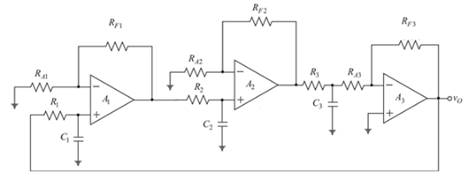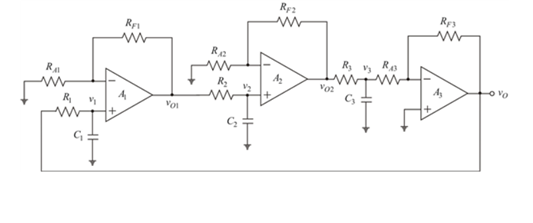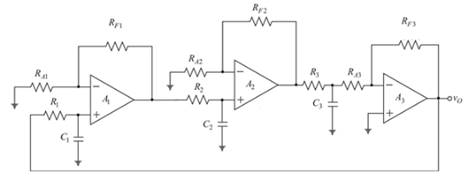
a.
The expression for the frequency of the oscillation.
a.
Answer to Problem 15.29P
The expression for the frequency of oscillation:
Explanation of Solution
Given:
The circuit is given as:

The circuit is redrawn by labeling the voltages as shown below:

Assuming:
Considering
Nodal analysis at the node
The amplifier gain of
Now, the output of
The nodal analysis at the node
Applying the nodal analysis at the inverting terminal of the
Solving equation (3):
Now, solving the equation (1):
Evaluating the frequency of the oscillation, use
Now, equating the imaginary values to 0:
Squaring the both sides:
Hence, the needed expression for the frequency of oscillation:
b.
The condition for the oscillation.
b.
Answer to Problem 15.29P
The condition for oscillation:
Explanation of Solution
Given:
The circuit is given as:

When,
The condition for oscillation:
Taking
Hence, the needed condition for oscillation:
c.
The condition for the oscillation.
c.
Answer to Problem 15.29P
The condition for oscillation:
Explanation of Solution
Given:
The circuit is given as:

Now substituting the values in equation 4:
Hence, the condition for the oscillation:
Want to see more full solutions like this?
Chapter 15 Solutions
Microelectronics: Circuit Analysis and Design
- Q13arrow_forward2) The transistor parameters of the NMOS device in the common-gate amplifier in Figure 2 are VTN = 0.4V, K'n = 100 μA / V², and λ=0. (50 points) a) Find RD such that VDSQ = VDs (sat) + 0.25V. b) Determine the transistor W/L ratio such that the small-signal voltage gain is Av=6. c) What is the value of VGSQ? Сс 2 mA Rp T V=-1.8 V V+= 1.8 V Figure 2arrow_forwardCalculate the percent voltage regulation for a three-phase wye-connected 2500 kVA 6600-V turboalternator operating at full-load Unity power factor The per phase synchronous reactance and the armature resistance are 10.4 2 and 0.071 ≤2, respectively?arrow_forward
- Don't use ai to answer I will report you answerarrow_forwardChose the correct answer: 1- A squirrel cage induction motor is not selected when (A) initial cost is the main consideration (B) maintenance cost is to be kept low (C) higher starting torque is the main consideration (D) all above considerations are involved 2- The torque of an induction motor is .............. (A) directly proportional to slip (B) inversely proportional to slip... (C) proportional to the square of the slip (D) none of the above 3- Insertion of resistance in the stator of an induction motor. (A) increases the load torque (B) decreases the starting torque (C) increases the starting torque (D) none of above tool to slip 10 or of the above 4- Increase in the length of air-gap in the induction motor results in the increasing of its (A) air-gap flux (B) magnetizing current (C) speed (D) power factor 5- In cumulatively cascade method for speed controlling, if PA is the number of poles of main motor and PB is the number of poles of auxiliary motor. Then the speed of the set…arrow_forwardChose the correct answer: 1- The resultant flux in stator winding of three-phase induction motor is equal to (A) Maximum value of flux due to any phase (B) Twice of the maximum value of flux due to any phase. (C) 0.5 times the maximum value of flux due to any phase (D) 1.5 times the maximum value of flux due to any phase 2- Which one of the following starters cannot be used for 3-phase, star - connected, slip-ring induction motor? (A) Auto-transformer starter (B) Star-delta starter (C) Direct-on-line starter (D) Rotor resistance starter 3- The crawling in the induction motor is caused by.............. (A) low voltage supply (B) high loads (D) improper design of the machine (C) harmonics developed in the motor 4- The 'cogging' of an induction motor can be avoided by........... (A) good ventilation (B) using DOL starter (C) star-connecting of stator winding (D) having number of rotor slots more or less than the number of stator slots 5- The method which can be used for the speed control…arrow_forward
- Manual solution only, no Al usedarrow_forwardChoose the correct answer: 1- The stator core of a 3- phase induction motor is laminated in order to reduce the Eddy current loss ) Weight of the stator (B) Hysteresis loss (C) Both eddy current and hysteresis loss - In cumulatively cascade method for speed controlling of a 3-phase induction motor, if PA is the number of poles of main motor and P, is the number of poles of auxiliary motor. Then the speed of the motor B is given by Ⓐ120f/ PA + PB CO (B) 120f/PA-Ps (C) 120f/PA (D) 120f/ Ps 3-Direct online starter is used for 3- phase induction motors having capacity COOOO ⑭Ⓐ Less than 5 h.p. (B) Less than 10 h.p. (C) Greater than 10 h.p. (D) For any capacity motor 4-Crawling of a 3- phase induction motor is a phenomena mainly associated with (B) 5th harmonics Ⓒ) 7 th harmonics (D) 2nd harmonics (A) 3rd harmonics 5-Cogging in a 3- phase induction motor is caused --------- (Ⓐ) If the number of stator slots are equal to number of rotor slots (B) If the motor is running at fraction of its…arrow_forwardChoose the correct answer: 1-We avoid line starting of induction motor and use starter because... (A) It will run in reverse direction (B) It will pick up very high speed and may go out of step Motor takes five to seven times its full load current (D) Starting torque is very high 2-DOL starting of induction motors is usually restricted to........... A Low horsepower motors (D) High speed motors (B) Variable speed motors (C) High horsepower motors 3- The method which can be used for the speed control of induction motor from stator side is......... (A) V/f control (B) Controlling number of stator poles to control Ns (C) Adding rheostats in stator circuit All of these 4-In cumulatively cascade method for speed controlling, if PA is the number of poles of main motor and PB is the number of poles of auxiliary motor. Then the speed of the rotor B is given by 120f/PA + PB (B) 120f/PA-PB (C) 120f/PA 5-The crawling in the induction motor is caused by.............. (A) low voltage supply (B)…arrow_forward
 Introductory Circuit Analysis (13th Edition)Electrical EngineeringISBN:9780133923605Author:Robert L. BoylestadPublisher:PEARSON
Introductory Circuit Analysis (13th Edition)Electrical EngineeringISBN:9780133923605Author:Robert L. BoylestadPublisher:PEARSON Delmar's Standard Textbook Of ElectricityElectrical EngineeringISBN:9781337900348Author:Stephen L. HermanPublisher:Cengage Learning
Delmar's Standard Textbook Of ElectricityElectrical EngineeringISBN:9781337900348Author:Stephen L. HermanPublisher:Cengage Learning Programmable Logic ControllersElectrical EngineeringISBN:9780073373843Author:Frank D. PetruzellaPublisher:McGraw-Hill Education
Programmable Logic ControllersElectrical EngineeringISBN:9780073373843Author:Frank D. PetruzellaPublisher:McGraw-Hill Education Fundamentals of Electric CircuitsElectrical EngineeringISBN:9780078028229Author:Charles K Alexander, Matthew SadikuPublisher:McGraw-Hill Education
Fundamentals of Electric CircuitsElectrical EngineeringISBN:9780078028229Author:Charles K Alexander, Matthew SadikuPublisher:McGraw-Hill Education Electric Circuits. (11th Edition)Electrical EngineeringISBN:9780134746968Author:James W. Nilsson, Susan RiedelPublisher:PEARSON
Electric Circuits. (11th Edition)Electrical EngineeringISBN:9780134746968Author:James W. Nilsson, Susan RiedelPublisher:PEARSON Engineering ElectromagneticsElectrical EngineeringISBN:9780078028151Author:Hayt, William H. (william Hart), Jr, BUCK, John A.Publisher:Mcgraw-hill Education,
Engineering ElectromagneticsElectrical EngineeringISBN:9780078028151Author:Hayt, William H. (william Hart), Jr, BUCK, John A.Publisher:Mcgraw-hill Education,





